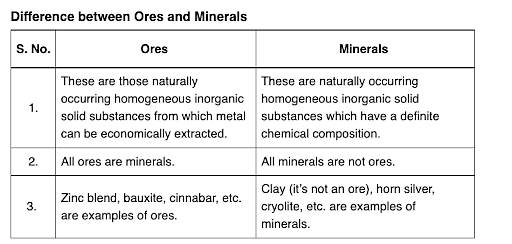The reaction that does NOT take place in a blast furnace between 900 K to 1500 K temperature range during extraction of iron is?
The reaction that does NOT take place in a blast furnace between 900 K to 1500 K temperature range during extraction of iron is?
FeO + CO \(\to\) Fe + CO2
C + CO2 \(\to\) 2CO
CaO + SiO2 \(\to\) CaSiO3
Fe2O3 + CO \(\to\) 2FeO + CO2
The Correct Option is D
Approach Solution - 1
The reaction FeO + CO → Fe + CO2 is a reduction reaction essential for extracting iron. Hence, this reaction does occur.
C + CO2 → 2CO represents the formation of CO, which is a reducing agent vital for further reactions. This takedns place.
CaO + SiO2 → CaSiO3 is a slag formation reaction to remove impurities and occurs within the furnace's temperature range.
The reaction Fe2O3 + CO → 2FeO + CO2 is not a typical occurrence at the given temperature range in the blast furnace process, as Fe2O3 is reduced in stages to obtain metallic iron, not reverted to FeO.
Fe2O3 + CO → 2FeO + CO2
Approach Solution -2
Fe2O3 + CO → 2FeO + CO2
This reaction does not take place at between 900 K to 1500 K temperature range during extraction of iron.
It takes place at between 500 K to 800 K temperature range.
So, the correct option is (D): Fe2O3 + CO \(\to\) 2FeO + CO2
Top Questions on General Principles and Processes of Isolation of Elements
- In the extraction of iron using blast furnace to remove the impurity (X), chemical (Y) is added to the ore. X and Y are respectively
- TS EAMCET - 2025
- Chemistry
- General Principles and Processes of Isolation of Elements
- What is used for the Thermite Reaction?
- BCECE - 2025
- Chemistry
- General Principles and Processes of Isolation of Elements
- Which of the following compounds is used to cover the surface of a metallic object to prevent corrosion?
- KEAM - 2025
- Chemistry
- General Principles and Processes of Isolation of Elements
A block of mass 1 kg is pushed up a surface inclined to horizontal at an angle of \( 60^\circ \) by a force of 10 N parallel to the inclined surface. When the block is pushed up by 10 m along the inclined surface, the work done against frictional force is:

[Given: \( g = 10 \) m/s\( ^2 \), \( \mu_s = 0.1 \)]
- BITSAT - 2024
- Physics
- General Principles and Processes of Isolation of Elements
A parallel plate capacitor with plate area \(A\) and plate separation \(d = 2\) m has a capacitance of \(4\mu F\). The new capacitance of the system if half of the space between them is filled with a dielectric material of dielectric constant \(K = 3\) (as shown in the figure) will be:

- BITSAT - 2024
- Physics
- General Principles and Processes of Isolation of Elements
Questions Asked in NEET exam
- A microscope has an objective of focal length \(f_o = 2\) cm and an eyepiece of focal length \(f_e = 4\) cm. The tube length of the microscope is \(L = 40\) cm. If the distance of distinct vision of eye is \(D = 25\) cm, the magnification in the microscope is:
- NEET (UG) - 2025
- Optical Instruments
- Which one of the following is an example of ex-situ conservation?
- NEET (UG) - 2025
- Ex-Situ Conservation
- Which one of the following compounds can exist as cis-trans isomers?
- NEET (UG) - 2025
- Organic Chemistry
- Who proposed that the genetic code for amino acids should be made up of three nucleotides?
- NEET (UG) - 2025
- Molecular Biology
- An electron (mass \(9 \times 10^{-31}\) kg and charge \(1.6 \times 10^{-19}\) C) moving with speed \(c/100\) (\(c\) = speed of light) is injected into a magnetic field of magnitude \(9 \times 10^{-4}\) T perpendicular to its direction of motion. We wish to apply a uniform electric field \( \vec{E} \) together with the magnetic field so that the electron does not deflect from its path. (speed of light \(c = 3 \times 10^8\) m/s):
- NEET (UG) - 2025
- Electric Field
Concepts Used:
General Principles and Processes of Isolation of Elements
What are Ores and Minerals?
Minerals are the naturally occurring, homogeneous inorganic solid substances. They are having a definite chemical composition and crystalline structure, hardness and color. For example, copper pyrite, calamine, etc.

Impurities in an ore are called gauge. The removal of a gauge from the ore is called concentration ore.
Several steps are involved in the extraction of pure metal from ores. Major steps are as follows –
- Concentration of the ore
- Isolation of the metal from its concentrated ore
- Purification of the metal